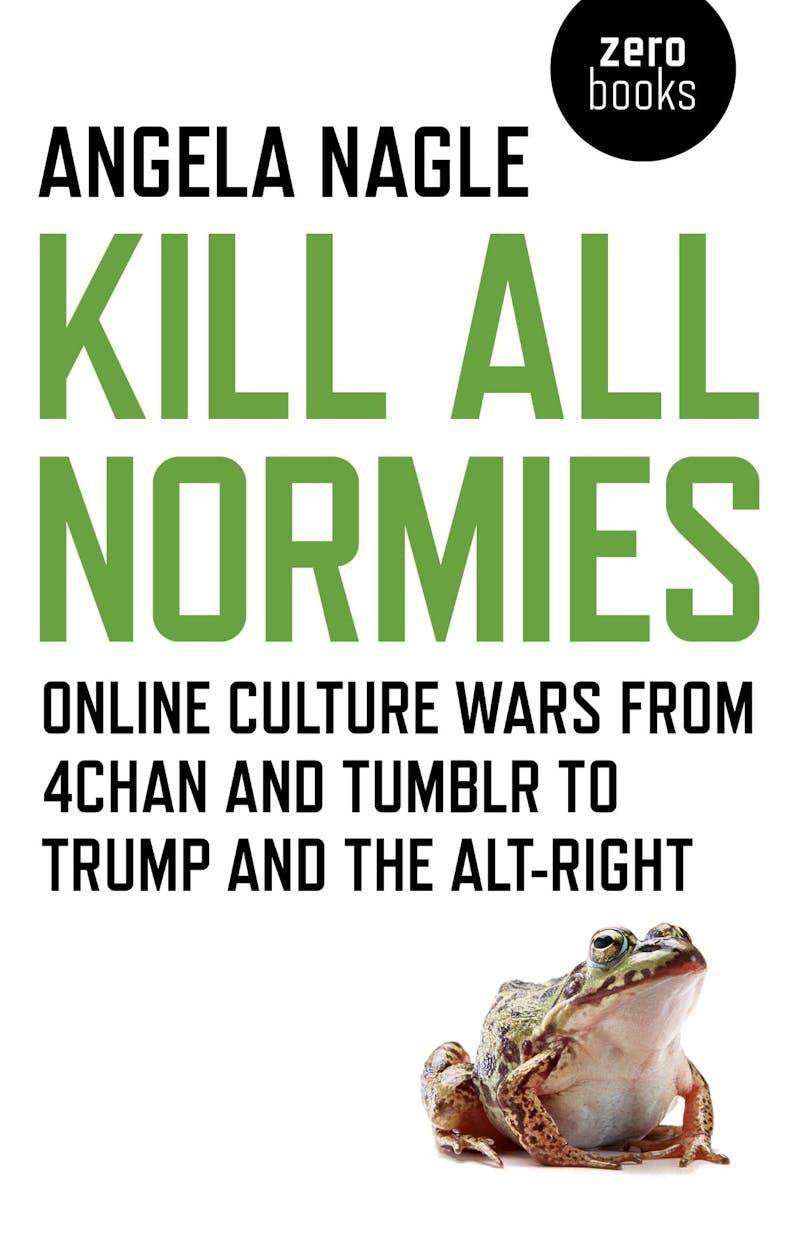It’s hard to know exactly how to define the alt-right. The movement, if there really is one, is amorphous, multifaceted, and prone to factionalism and internal squabbling. Last year, the Wall Street Journal defined it as a “loose but organized movement” that united different strains of ultraconservative politics with white supremacy and niche online cultures. To some extent, the paper was saying what the alt-right wanted it to say: It was a movement, it had its 15-minutes of fame, and it was different from the conservatism of Ayn Rand-devotees like Paul Ryan. Months before The Atlantic caught the term’s self-proclaimed founder—Richard Spencer—on camera among a mass of Sieg Heil-ing men in the basement of a U.S. federal building, this once obscure political phenomenon was brought into the limelight.

While this eclectic array of far-right groups might have faded into obscurity under a Clinton administration, Trump has given America’s fanatical rightwing a much needed boost. The “God-Emperor,” as some in the alt-right are fond of calling him, was hardly their ideal candidate or the poster boy for Aryan racial supremacy. But he was the perfect symbolic leader for an online cultural clash that has been years in the making.
In Kill All Normies: Online Culture Wars from 4Chan and Tumblr to Trump and the Alt-Right, published by Zero Books, Angela Nagle plumbs the depths of the noxious digital morass that fed off Trump’s rise. Where some have seen unfathomable chaos, Nagle—an academic and journalist who’s covered digital subcultures extensively—aims to faithfully document the online culture wars that “may otherwise be forgotten.” By presenting one of the few holistic and sensible taxonomies of the alt-right, Kill All Normies offers a bulwark against desultory assessments of the movement that blur the myriad of ideological differences that make the movement’s origins and goals feel impenetrable. It is also a wake-up call to those on the left-liberal spectrum that it is high time they got their act together.
Nagle approaches the alt-right as a meta-group of semi-divergent subcultures, including the eclectic cadre of feminist-hating chauvinists in the “men’s rights movement,” Pepe-wielding shitposters, “dapper” white ethno-nationalists, pseudonymous neoreactionary theorists, and “alt-light” allies like Milo Yiannopoulos and Steve Bannon. (Both men have, in the post-election period, fallen out of favor, specifically with many in the movement’s white nationalist contingency.) As a result, WSJ’s use of “organized” may be questionable here. The alt-right is better understood as a broad coalition of internet and intellectual subcultures—some of which are organized—that briefly came together over a shared goal: to elect Donald Trump to the highest office in the land.
Among this loose coalition includes a hardcore white nationalist contingent, consisting of think tanks like the National Policy Institute and American Renaissance, as well as intellectual figureheads and movement leaders like The Occidental Quarterly’s Kevin MacDonald, AmRen’s Jared Taylor, Daniel Friberg of Arkos Media, and, of course, Spencer himself. While this “big tent” approach comes at the expense of ideological purity, many within the white nationalist old guard have admitted, reluctantly or otherwise, that this doddery coalition has benefited their cause tremendously. As Greg Johnson, editor-in-chief of the white supremacist publishing house Counter Currents, wrote shortly before Trump’s inauguration, while white nationalists need to remain realistic about the fault lines that exist between them and so-called “alt-light,” they ought to treat this brief alliance as an opportunity. Even though the alt-light is driven by “civic nationalism as opposed to racial nationalism,” they ought to be looked upon “as potential converts to white nationalism.” For a movement plagued by websites that look they came from 1997, that is a hefty boost.
When it comes to online culture wars, few groups are as well-known or well-recognized as the “channers.” Racist, sexist imageboards on 4chan and 8chan have been both embraced and viewed with some skepticism by the alt-right’s more overtly white nationalist contingent, but they helped usher the far-right into the broader public consciousness. “What we call the alt-right today could never have had any connection to the mainstream and to a new generation of young people if it only came in the form of lengthy treatises on obscure blogs,” Nagle explains. The memification of the alt-right, its transformation into rapidly reproduceable images and short phrases, was what allowed it to spread so contagiously. It was the political discussion board /pol/ (i.e., “politically incorrect”) on 4chan and 8chan, and the subreddit /r/The_Donald that “gave the alt-right its youthful energy, with its transgression and hacker tactics.” It was the channers, too, who facilitated the alt-right’s move into mainstream internet culture, whether through “raids” (coordinated efforts to disrupt the content on a site, through, say, extended and vulgar comment threads), memes, or trolling. Memes like Pepe, (((echoes))), and Kekistan—all of which are now commonly referenced by young white nationalist groups like Identity Evropa or the youth contingent of the National Policy Institute—have even become a staple at far-right protests throughout the country.
This tentative allyship between a wide variety of bigots and regressives flies in the face of the onetime consensus that the internet would usher in an information utopia. Instead of encouraging our best impulses, the internet has enhanced our worst ones, and the alt-right may be the clearest proof. As Nagle sees it, the cooption of 4chan’s more sinister racialist elements by a broader political movement is a natural outcome of the troll-happy culture that gave rise to, say, Anonymous’s 2008 war against Scientology. The leaderless anonymous culture that once enchanted scholars such as Gabriella Coleman “ended up becoming characterized by a particularly dark preoccupation with thwarted or failed white Western masculinity as a grand metaphor,” says Nagle. This breed of internet troll—which flourished on both the chans and Reddit—held such a disdain for mainstream social norms that anything, no matter how noxious, that could be conceived as countercultural was welcome. Who cares? It is all ironic anyway!
As older conservatives fought out the 2016 election in the pages of the National Review and the Weekly Standard, a younger, more tech-savvy generation of neoreactionaries, white nationalists, ultra-conservatives, and traditionalists took to some of the darkest corners of the web to stake out their role in American political life. To do so, they embraced a transgressive and performative approach—one that, Nagle writes, is “more Fight Club than family values, more in line with Marquis de Sade than Edmund Burke”—inspired not by the work of conservative ideologues but by the tactics of left-wing vanguards. Soon, those “heeding the ideas of the left most closely . . . and applying them most strategically [were] the right.” Rightist troll culture embraced the notion outlined by critical theorists such as Michel Foucault and the New Left thinkers like R.D. Laing that madness is a political and cultural rebellion, and in their hands this idea meant that a position of contrarianism and opposition to consensus values became an end unto itself. Indeed, Nagle explains, the “libertinism, individualism, bourgeois bohemianism, postmodernism, irony, and ultimately the nihilism that the left was once accused of by the right” has found fertile ground in segments of the new far-right.
The alt-right has also demonstrated a proclivity to steal and distort pieces of left-wing theory at will, all the while unironically harping on the dangers of so-called “cultural Marxism.” Much like one of its ideological forerunners, the French New Right, the alt-right has embraced a Gramscian approach to political change by focusing almost laser-like on what they view as left-wing cultural hegemony. “The point is ultimately to redefine the conditions under which politics is conceived,” Friberg explained in an excerpt from his book The Real Right Returns. “Only by understanding this tool, countering its misuse, and turning it to serve our own ends, can we overcome the miserable situation that our continent is in.” He is referring to Europe, but the same could easily be said of the United States, where the far-right is well aware it lost at least one stage of the culture wars. It is posed to turn its enemies’ tactics against them.
For the left—fragmented as it is—that ought to set off sirens. While radical political countercultures may be flourishing in some online communities, the prevailing leftist discourse that the far-right, and even mainstream right, have targeted is, in Nagle’s words, a “cult of suffering, weakness, and vulnerability.” Admittedly, some of the manifestations of this behavior she cites may be outside the scope of most casual internet users—if you’re not invested in these conversations or specifically seeking them out in order to find something to make you mad, you’re not likely to find these sections of the liberal web. Still, a segment of the internet left’s obsession with victimhood—from the fetishization of mental illness to the Everyday Feminism-style declaration that using phrases like “Fuck you!” perpetuates rape culture—has trickled out into the open, manifesting itself on both social media and college campuses. The latter have become especially contested spaces, as right-wing youth groups—bolstered by behemoths like the Koch brothers—draw an array of racist and sexist ideologues in an effort to troll the left into an outraged response.
Nagle focuses less on whether this critique of the left is fair and more on the influence of left-wing cultural politics on the alt-right, which has presented itself as a counterweight to the alleged oversensitivity of the left both mockingly and in earnest. While the alt-right has proffered itself as a viable alternative to this inane, even corporatized, version of liberal identity politics, the new far-right’s actual position on this form of politics is far more complicated. Rather than abandon the notion of a politics centered around personal characteristics, parts of the far-right have actively pronounced their support for an identity-centric politics—“identitarianism,” as they call it. Many—like Spencer, whose organization even hosted a conference entitled “Identity Politics” in March 2016—see white identity politics as the natural opposition to GOP-style conservatism (or, in the alt-right’s terminology, “cuckservatism”), as well as left-wing socialist and liberal movements. The tribalist approach to gender and sexuality found among men’s rights activists indicates an affinity for this political strategy, too. The effect is that the anti-racist, anti-sexist identity politics that have sought to unite women, LGBT people, and people of color on the left have found a grotesque parallel in a pro-racist, pro-sexist identity politics that seeks to ignite the rage of white men on the right. The alt-right’s belief is that the pluralism and multiculturalism that have attended the global liberal order of the postwar era can be eradicated by white supremacy, male supremacy, and a highly ordered, hierarchical traditionalism.
Much of the model for this far-right breed of identity politics, says Nagle, has been copied from what she calls “Tumblr-liberalism.” Here, she says, the left reaches “its most absurd apotheosis with a politics based on the minutiae and gradations of rapidly proliferating identities,” many of which reek of a last-grab for self-actualization rather than substantive constructions. Even though the left-wing “snowflake” concocted by the right is a strawman, online liberalism has developed a style of politicking that encourages a tendency to factionalism and internal squabbling that benefits its opponents. A coherent left strategy that both opposes structural racism and sexism and also finds substantive common ground has not yet emerged. If the internet is a trial run for real-life political action, then it’s clear that change is in order. As Nagle observes, if the left is to proceed, “it may be time to lay the very recent and very modern aesthetic values of counterculture to rest, and create something new.” Something that the right can’t co-opt.
